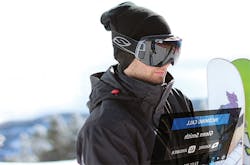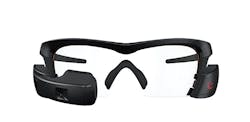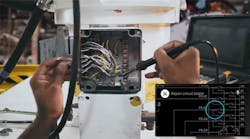Style & Substance: The New Wave of Industrial Wearables
A story about wearables, particularly smart glasses, doesn’t have to begin with talking in detail about Google Glass. We’ll assume you know the Hindenburg and Titanic had longer periods of public adoration than the over-priced, headache-inducing eyewear.
Instead of that usual behemoth’s fall from grace tale, in this two-part series, we’d like to introduce some plucky startups: Recon Instruments (Part 1), now owned by Intel and maker of the Recon Jet Pro smart glasses, and Upskill (Part 2), formerly APX Labs and developer of the Skylight enterprise wearable software solution.
These two companies quietly entered the fourth industrial revolution through the side door and are on the verge of becoming the rock stars of the industrial wearable market.
And that wearable market is soon to be huge. It’s expected that 8% of all American workers will use smart glasses on the job by 2025, according to Forrester Research. And the workers will need them to keep up with an increasingly automated world—Forrester also predicts a net job loss of 7% in that same time because of AI and robotics.
Our flesh and gray matter alone can’t match the might of semiconductors and servos. By allowing workers to seamlessly interface with machines, big data, and other people, industrial wearables turn them into the best IoT device in the plant, and make it so employing humans can still be a better value proposition than bringing in robots.
In that way, you can look at industrial wearables as the most important tool you’ll use in the coming decade. Or, if you equate job security to freedom, you may even consider these weapons in some epic fight for humanity. Either way you look at it, it will take the combined forces of hardware and software working together. This is the solution the biggest companies in the world are using, including Boeing and General Electric, so you might want to get familiar.
Hardware: The Recon Jet Pro
We begin on the snow-capped summits of the North Shore Mountains peering over Vancouver, B.C. The year is 2008, and a group of MBA students at the University of British Columbia have decided to commercialize a heads-up display for skiers and snowboarders.
The newly incorporated company, Recon Instruments, originally intended to make high-tech swimmers’ goggles, but the small form factor and waterproofing of electronics proved to be engineering impediments. Larger, rugged-yet-ergonomic skiers’ goggles, though, would be easy to embed with sensors and electronics. And these mountains would be the perfect place to product test.
“What we realized is we were able to completely hide the electronics and the display in the snow goggles,” recalls Mario Palumbo, the former VP of Engineering for Recon. “The key was coming up with use cases that people who ski or snowboard would care about.”
Photo: Intel
The inertial sensors, including the gyroscope, magnetometer, and altimeter that Recon embedded, allowed the skiers to gauge vital data that instantly appeared right on the display, such as how long they spent soaring in the chilly alpine air and other totally extreme metrics, like 3D speed, GPS tracking, vertical distance traveled, temperature, and time. This data could then be shared on social networks assumingly to show up that jerky ski instructor who is after your girl. Officially, the company says their products are made to help athletes push their performance to new levels.
An unextreme way to put this is that the device gathered several sets of relevant data to increase user efficiency. How many times has that been written in these pages?
Their initial offering, the $399-499 Transcend, became the first heads-up display for athletes.
“Recon was actually one of the pioneers in heads-up displays,” says Chris Croteau, general manager of the wearable devices unit at Intel. “They were country before country was cool—long before Google came out with Glass and other people who were in the market.”
By 2013, Recon had sold 50,000 wearables compared to a few thousand from Google. This was enough to draw Intel’s attention, which subsequently invested in the startup. By 2015, the great Glass elevator hit rock bottom and was abandoned.
Meanwhile, Recon grew stronger and evolved with the sensor and smartphone technology, adding a better CPU, sensors, more connectivity, and a POV camera and audio. One offshoot became the Recon Jet, which looked more like Oakley wraparound sunglasses. You could swap out the lenses for a multitude of sports and environments. The smart glasses’ appeal expanded to runners, cyclists, and even skydivers, because when you jump out of a plane, you want to record it for posterity.
The Recon Jet's display is ergonomically positioned to reduce eye strain and distractions, both good features if you're flying down a hill at 40 mph.
Photo: Intel
The factory floor may not get the adrenaline pumping like a freefall from 5,000 feet, but these smart glasses had nearly everything you’d want if you had to wear a pair for your shift: an array of sensors, connectivity, durability, and comfort. Recon’s design already gathered several sets of relevant data to increase user efficiency. What Industrial Internet of Things tool doesn’t try to do that?
The potential to radically transform how humans interface with machines and data was always there. It’s like how you always knew you were management material, but needed a decade of rebellious debauchery to figure that out.
All this thrill seeker needed was a little push.
Enter Intel, which acquired Recon Instruments in 2015.
Intel wanted to see how these ruggedized glasses would hold up in an industrial work setting, so they supplied Recon’s smart glasses to their manufacturing and logistics workers as part of a pilot program, Croteau says.
Typical warehouse picking operations, which accounts for about 55% of labor resources, according to the European Journal of Operational Research, can be quite ungainly and time-consuming with conventional scanning tools.
“Similar functions can be done on a tablet or on a PC, but then I’ve got to have a crash cart rolling around with me, or I’ve got to have a tablet somehow in a pouch ,or a bigger phone, or a tablet kind of thing tethered to my belt,” Croteau explains. “And I’m constantly looking off of my work and down to a screen.”
So instead of an RF gun, they strap on the glasses and use a ring scanner for hands-free picking. Other hands-free options, such as picking by light, which spotlights boxes on the racks, require expensive infrastructure and aren’t 100% error proof.
“We’re giving them that screen that gives them the information they need without distracting them from the work that they’re focused on -- and without occupying their hands. So there’s an efficiency angle and a safety angle,” Croteau says.
One pilot project, which also used a Zebra RS507 ring scanner and Ubimax xPick application, at Intel’s Glendale, Ariz. distribution center, initially saw an immediate 15% drop in picking time. After a month of practice, that grew to a 30% decrease.
Pickers account for around half of the labor in a warehouse, and Intel says the job is the “single most costly and labor-intensive activity in the whole supply chain.”
So it didn’t take long for word to get out that Intel was experimenting with a technology that could free up logistics workers and the 1.3 billion mobile workers around the world.
“We were getting at least five calls a week from big corporate customers about Recon,” Croteau says. “At the time it wasn’t really designed for industrial use. We didn’t have solutions built on it but the pent-up demand was so overwhelming that we put a plan in place to create a derivative product that we call the Jet Pro.”
- Smartphone-class computing
- Bluetooth, Wi-Fi, and GPS
- Distributes weight of components evenly frame
- Fully adjustable nosepiece and ear stems
- Swappable Lens: Clear or Gray Polarized
- Fits nearly all head shapes and sizes
- POV camera enables see-what-I-see video calls
- Battery: Approx.2-5 hour runtime
- Validated for use with ERP, PLM, MES, and WMS systems
The Recon Jet Pro ($599) works for indoor and outdoor environments, with a sunlight-readable display, waterproof components, and a swappable battery that can last up to 5 hours. A patented glance detection function saves more power by switching off when you aren’t looking at the LCD. A 720P camera records video, which can be streamed via Bluetooth or WiFi from the field to a remote expert.
“So now instead of sending your most experienced worker all the way out to the hardest problem, you can keep them in the office and send your newer workers out,” Croteau says.
The ergonomic design of the consumer and industrial versions are nearly identical, but some changes needed to be made to make the glasses to make them fit for the industrial crowd, which have to meet several safety standards and guidelines.
For industrial applications, the fit needed to be tighter so it can pass the ANSI Z87.1 standard ballistics test, which ensures that if a projectile flew off a machine, the face shield would hold. It could still be removed in case of damage to the lens or if the worker is going from an indoor to outdoor environment.
“What’s great about polycarbonate is it won’t shatter, but it will scratch more easily than glass,” says Palumbo, who’s now the director of technology for Intel’s wearables division, “so the swappable lenses are a key feature”. He also mentions prescription glasses are able to fit under the face shield.
Another major selling point is the ergonomics. The front curves to contour to your face, with an adjustable nosepiece, and the rear third of the ear stems are rubber over wire, and adjustable to prevent pinching. And the weight is evenly distributed.
“We’ve made them as comfortable as we can, because it’s something you’re wearing for quite a while,” Palumbo says. “But we also made them as stylish as we can. In manufacturing and other enterprise environments, you get a bit of a pass, but we’re still human beings wearing them so we want to wear the thing that kind of looks the coolest.”
It’s finding the perfect balance between function and fashion, really. And given that the adrenaline junkies shredding on ski slopes and zooming through urban bike trails have accepted the Jet, the industrial workers who have become accustomed to plastic one-size-fits-all safety glasses and orange mesh vests that scream crossing guard chic will no doubt appreciate the upgrade.
Screengrab: Intel/ YouTube
And along with not making you an eyesore, the Jet Pro is optimized to inhibit eye strain.
Research has found that monocular heads-up displays can cause muscle fatigue in the eyes, visual confusion, and binocular rivalry, the perceptual effect that makes objects overlap, like watching a 3D movie without the glasses.
Photo: Google
“Forcing your eye to look up and read the display promotes eye strain due to the eye muscles not being trained for that,” Croteau says. “It’s one of the primary reasons that the Recon products (Snow2 & Jet/Jet Pro) are designed with the display slightly below your eye level. That is the easiest and most comfortable place to view a display.”
One other key feature, the patented glance detection technology, blacks out the HUD when it’s not in use and wakes up when it senses the user is looking at it. With glance detection on, the smart glasses consume 25% less power.
So the wearable side of the solution was in a great place. The usable side though, needed work, as training for the Tour de France and optimizing a picking application have very little crossover. They needed more than a killer app, they needed a full-on software solution geared for critical industries.
Click HERE to find out how Intel and several other leading manufacturers found a solution in Part 2.
About the Author
John Hitch
Editor, Fleet Maintenance
John Hitch, based out of Cleveland, Ohio, is the editor of Fleet Maintenance, a B2B magazine that addresses the service needs for all commercial vehicle makes and models (Classes 1-8), ranging from shop management strategies to the latest tools to enhance uptime.
He previously wrote about equipment and fleet operations and management for FleetOwner, and prior to that, manufacturing and advanced technology for IndustryWeek and New Equipment Digest. He is an award-winning journalist and former sonar technician aboard a nuclear-powered submarine where he served honorably aboard the fast-attack submarine USS Oklahoma City (SSN-723).







